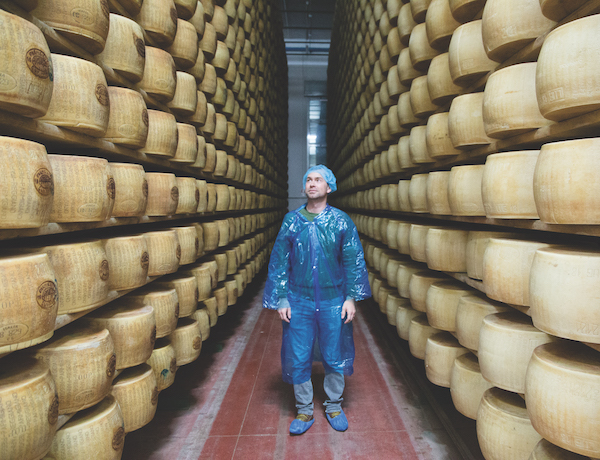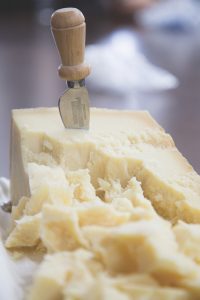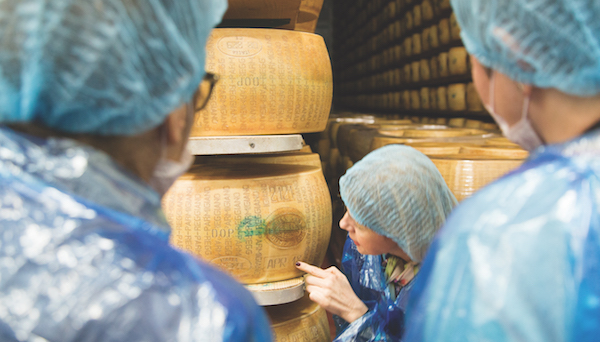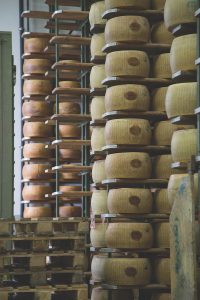Chris Allsop flies to Emilia Romagna to tour a Parmigiano Reggiano dairy and discover how this world-famous cheese is created…

“When I have French groups, they have many excellent cheeses, but they do not have Parmigiano Reggiano.” Our guide, Helena, puts her fingers together and gestures aggressively. “They have to accept.”
Only five minutes into the tour of the Santo Stefano Dairy – one of around 330 dairies in a strictly delineated section of the agricultural heartland that is the Emilia Romagna province – I hadn’t (perhaps naively) expected the rivalry between the great cheese nations to bubble up so quickly. But it’s hard to argue with Helena – perfectly made up beneath the blue plastic hygiene hat and smock that we’re all wearing – as, while France has many world-beating cheeses, it doesn’t have anything to rival the fruity, multi-purpose, hard-aged magnificence of Parmigiano Reggiano.
This mainstay of the western fridge cheese compartment has remained almost unchanged since the 12th century, when it was first created by Benedictine monks as a winter foodstuff. Today, it’s a treasured cornerstone of Italian cuisine, its punchy, complex flavour as suited to being eaten in raw crystalline
chunks as it is to being melted into a sauce.

Tradition and reputation
Since 1928, the Consorzio del Formaggio Parmigiano-Reggiano – a trade union to which all Parmigiano Reggiano producers belong – has set about ensuring that the tides of capitalism don’t erode the traditions or reputation of this cheese. An EU PDO mark protects the name and production process that also dictates that the cheeses have to be made within the geographical confines of the provinces of Parma, Mantua (to the east of the Po River), Reggio Emilia, Modena and Bologna (to the west of the Reno River).
“You can see it from space.” Helena points towards the blank ceiling of the dairy’s corridor. She’s talking about the geographical region, of course; its contours are apparently visible from the window of the International Space Station. Though actually you could also see the cheese itself in space, as since 2005 Parmigiano Reggiano has been included as part of the official diet for astronauts in orbit.
But back to terra firma. We follow Helena into the dairy proper, the air becoming heavy and humid. Santo Stefano, a family-run concern with three generations somehow not murdering each other as they share a workplace, is a slightly larger version of the average Parmigiano Reggiano dairy. It’s certainly modern – no farmer and barn set-up this – with stainless steel tables, computerised equipment, and uniform white wellies for the workers going about their business. For all the modernity, I’m glad to see that the spino, the long stick used to break the curd into granules, has only adapted a little from its traditional shape and continues to look like an obscure gladiatorial poking stick.

Keen rivalry
Despite the consortium and everyone pulling together to put out last year’s record 3.7 million wheels for an overall turnover of €2.4 billion euros, there’s apparently a keen rivalry between the dairies to put out the kingliest of the Parmigiano Reggiano available. Making for a level playing field is the milk, sourced from a shared selection of around 3,000 small farms, the herds all fed on the diverse, magical PDO pastures that produce milk that has that special something.
So strict is the PDO, that the cows are not allowed to be fed on ‘silage, fermented fodder, or grain based on animal products’ as these feeds could contain preservatives (super strictly prohibited) that might possibly make their way in to the finished cheese. The raw milk is delivered to the cheese factories, with 520 litres of milk used in the production of each enormous 38-kilo wheel of cheese (staggeringly, Parmigiano Reggiano production uses over 15 per cent of Italy’s total milk production).

In the production room, with shallow, copper-lined vats steaming with warm milk , we watch the cheese take shape (see more here). The milk, naturally skimmed from sitting in the vat (the cream is packaged off to make butter), slowly separates into curds and whey with the addition of animal rennet and a microbe-rich starter taken from the previous day’s production. Vigorous poking with the spino keeps the curd grains small while they cook, before they settle and coagulate into a huge lump of curd at the bottom of the bell-shaped vat. With a long wooden paddle, it seems the smallest man in the dairy is then tasked with levering up this giant aspirin tablet of solid milk, which is then split in two to create ‘twin’ cheeses . These are suspended in cheesecloth to drain. If there isn’t enough milk to make twins, an M is inscribed on the single cheese produced denoting it, in true Italian fashion, as a ‘Male’.
Wiping our collective brows at the effort involved, we walk out – beneath a Latin inscription that reads ‘in work is the true rest of life’ – and through to where the still soft cheeses are contained within moulds. There’s another group in here, so while we wait Helena asks conspiratorially for gossip on Meghan and Harry. We eventually go in to find the cheeses tightly wrapped in plastic collars ; this is also the stage at which their stylish plastic cummerbunds – that imprint authenticity and tracking info onto the cheese exterior – are put on. The cheeses are then sunk into a brine mixture that adds flavour and antibacterial properties, before being transferred to the ageing room.
Trusted process
In the ageing room, the amount of weight held by the vertigo-inducing shelving is staggering. The smell as you enter is powerful, richly savoury, not quite what you get when you snap apart a fruity piece of Parmigiano Reggiano, but reminiscent of it. The cheese is aged on these shelves for 12 months minimum (only then can it be deemed ‘Parmigiano Reggiano’) and so reliable and trusted a process is this that banks will accept a producer’s stored cheese as collateral for loans. Maintaining this product confidence is a matter of the utmost concern, so after a year of ageing the inspectors from the consortium arrive to test every wheel.

Helena hands us a little double-headed hammer with a flat handle and invites us to tap a wheel. The hammer bounces readily back off the Parmigiano Reggiano drum, and we listen for where the dull tap alters, indicating an interior fault. If the cheese passes, a fire stamp on the rind is added to indicate that it’s the real deal. If not, the cummerbund branding is scraped off and it is branded Mezzano and sold cheap in the domestic market (lucky Italians).
Our tour ends with a tasting flight of Parmigiano Reggiano aged 12, 24, and 36 months (as a comparison, an average mature cheddar is aged nine months). The 12-month-old is more pliable and milkier in flavour, as you’d expect, while the 24 – what we tend to find in our supermarkets – has rich pineapple notes. The third, looking more like mineral than foodstuff for that third summer it’s sweated through, has a pronounced nuttiness with flavours of allspice accompanying the fruit. There’s also more of a delicious crunch of tyrosine crystals, caused by degenerating proteins, in the bite.
Bookings for tours
I didn’t really need any convincing, but a tour of a Parmigiano Reggiano dairy brought home the quality and history of this totemic product. While the dairies are obviously rather busy pleasing the world’s cheese eaters, there are some that take bookings for tours (Find out more here). Happily, no bookings are required to pop into your local cheese shop and buy a decadent wedge of this most royally delicious of cheeses.
See a step-by-step of the cheese-making process here, and you’ll find more on Parmesan in our archive
